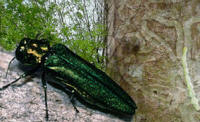|
 Borers and their control Borers and their control
 Send a link to a friend
Send a link to a friend
By John
Fulton
[May 14, 2007]
Few things strike fear in the hearts of tree
owners like the mention of borers. Borers are most often the larvae
of beetles or moths, and they do their damage where you can't see
it. The eggs are laid on or under the bark, and the small hatchling
chews through to the part of the tree they feed on. They spend
almost their entire lives inside the tree, where they can't be seen
or controlled.
|
|
Most borers are named for their primary target, but they also
affect other species of trees and shrubs. As an example, the
flatheaded apple borer can also affect pin oaks and about 15
other species. Many borers leave a telltale hole in the trunk,
but some, such as the ash borer, are weak and have to enter
through a pruning or mechanical injury. Here is a listing of
common borers and their control times: ash borers, early June
and early July; bronze birch borer, mid-May and repeat two times
at two-week intervals; dogwood borer, mid-May and mid-June;
flatheaded apple borer, late May and repeat in three weeks;
lilac borer, early June and early July; locust borer, late
August and mid-September; mountain ash borer, early June and
mid-July; peach tree borer, mid-June and mid-July; viburnum
borer, early June and early July; and Zimmerman pine moth, April
or August.

You can see borer control isn't an exact science. Treatment
times and reapplications are hopefully timed to catch the
hatching eggs on the outside of the trunk or discourage the
adults from laying eggs.
Some new research shows that trees that are under stress give
off a certain pheromone that attracts more borers to the tree.
Zimmerman pine moth is one of that "kind of borers." It
generally affects only severely weakened trees and goes just
under the bark to girdle the cambium layer. It seems like older
Scotch, red and Austrian pines are favorites when they begin to
decline.
[to top of second column]

 |

So, keeping your trees in good growing shape will go a long way to
helping the situation. Fertilizing with the same rate of broadcast
fertilizer used for lawns will help (apply it early May and early
September), and watering during extreme dry periods as well (with an
inch of broadcast water per week). Trees actually get their food
and moisture from small roots located in the top eight inches or so
of soil. That big taproot is actually an anchor and doesn't take up
much in the way of food or nutrients. The root mass generally goes
out about 1.5 times as far as the branches do. The shallow roots are
part of the reason it is hard to grow grass under trees. Sure the
shade has something to do with it, but the tree roots are more
efficient at getting water and nutrients.
Back to the borers. The product of choice for many borers is now
permethrin, since Dursban is off the market. Fruit trees generally
are treated differently with Sevin or just by using the regular
spray program due to the possibility of residue in fruit. Bronze
birch borers can be controlled with imidacloprid. Treatment of the
trunk and main limbs is the goal of borer treatments.

Good luck in your borer control attempts. If you miss the timing,
you can try to run a stiff wire in the hole. At least it may make
you feel better than doing nothing at all.
[Text from file received from
John
Fulton, University of Illinois Extension,
Logan County Unit]
 |